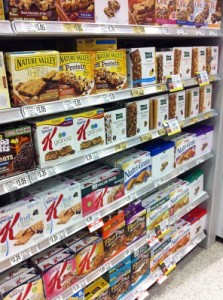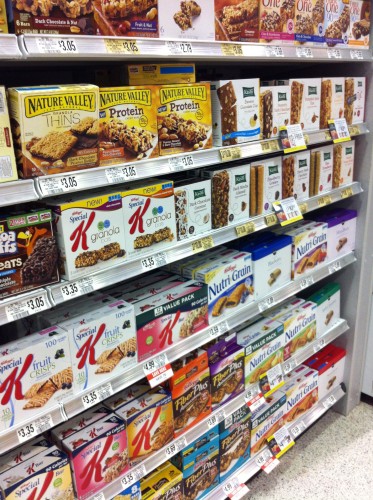 Snack Bars seem to be a God-send to the health conscious. A few years ago Nature Valley came out with the first granola bars. Since then snack bars have quickly become one of the most popular on the go food items you can buy.
Snack Bars seem to be a God-send to the health conscious. A few years ago Nature Valley came out with the first granola bars. Since then snack bars have quickly become one of the most popular on the go food items you can buy.
Why are they so popular? Well for one thing they are super convenient. You can keep a couple of snack bars in your bag or car for any time you get hungry. Snack bars are easy as a lunch box treat for the kids too. They don’t perish easily, they taste great and best of all they claim to be really healthy.
But are they really healthy?
Unfortunately the answer for most of them is “not really”. The snack bar craze has been fuelled by people who are searching for a quick, healthy energy boost. But most of the time you could just as well eat a regular candy bar instead.
What’s inside a snack bar?
Some of the products claiming to be “natural” are anything but.
Take a look at the ingredients printed on the back of the wrapper. You will easily see the difference between the good, the bad and the ugly of the snack bar world.
Many snack bars that claim to be healthy contain all kinds of ingredients that are bad for you. Let’s take a look at the most common of these one by one.
Flavor enhancers: Almost all flavor enhancers, even those claiming to be natural, are bad for you. Companies create synthetic versions of natural ingredients. These are not the same as the natural products they claim to be and they are not healthy.
Colorants: There are many sites that will tell you exactly what each food colorant does to your body. But how often do you stand in the middle of a shopping isle reading up on the ingredients in your food? Just remember the vast majority of chemical colorants will cause hyperactivity, asthma and cancer. That should be enough to put you off anything that contains colorants of any kind.
Preservatives: We all know how bad preservatives are for your body. Again, there are many websites you can visit to find out exactly what each one does to you. The general rule of thumb, though, is that you should avoid them.
Unpronounceable ingredients and E-Numbers: You should be immediately cautious if you can’t pronounce the names of any of the ingredients in your food. The same goes for E-numbers. Anything with an E-number is an additive and most likely has a name you can’t pronounce. Take a look at which E-Numbers it is safe to eat.
Palm Oil: Palm oil in itself is as bad for you as any other saturated fat, but that is not the worst thing about it. The methods used to harvest palm oil are causing one of the biggest ecological disasters of our time. You should say no to any product made with palm oil.
Canola Oil: Almost all Canola oil is genetically modified (GMO).
Hydrogenated Oils (Trans fat): .Hydrogenated oils increase bad cholesterol and decrease good cholesterol. They also stop your body from being able to regulate inflammation. Inflammation is bad news and tends to cause more serious problems.
Sugar
Sugar: The biggest culprit you will find in almost every snack bar, even the all-natural ones, is sugar. Take a look at the Lara bar for example. The average Lara bar contains 18 grams of sugar. That’s four and half teaspoons! A teaspoon of sugar is 4 grams, so you can work out how many teaspoons of sugar are in anything with a simple equation. Just take the number of grams of sugar and divide by four and you have the number of teaspoons of sugar in your bar.
We know that sugar causes belly fat and increases your chances of developing type 2 diabetes. Sugar also causes you to have an energy crash and actually makes you hungrier the minute your body is done processing it! So you are actually more likely to overeat after you have had something sugary. You will have less energy than before you ate your energy bar!
Sugar by any other name: Is still sugar. There are many different kinds of sugars. Some of them are not as bad for you as others, but all them have the belly fat effect mentioned above.
Ingredients that are basically refined sugar: cane sugar, brown sugar, barley malt, fructose, high fructose corn syrup, maltodextrin, dextrose, glucose and agave. If something ends in “-ose” or contains the word “syrup” or “malt” it is either a sugar or a refined carbohydrate.
How to spot a healthy snack bar
Take a look at the list of ingredients and nutritional values printed on the back of the wrapper.
A healthy snack bar should contain less than 10 grams of sugar per portion. Look for a snack bar that has more or less equal quantities of protein and sugar. Look for high fiber and high protein. A snack bar with high protein and high fiber will give you more lasting energy and keep you feeling full for longer.
Look for a snack bar that contains ten ingredients or less. Make sure that all of those ingredients are things that you understand. In other words they should be ingredients that you would recognize on their own and not have long, chemical names you can’t understand.
Look for bars that contain whole grains, real seeds and nuts and unsweetened fruit. You want a snack bar that is made out of as many real, natural ingredients as possible and as little sugar as possible.
If you are still in doubt after you have taken a good look at what’s in the bar – leave it on the shelf.
If you are struggling to lose weight, it might be due to your body’s hormones that are affecting your metabolism. Check out this video on the 2 hormones all skinny people have in common.
About the Author:
Emma Deangela is the best selling author of The Alkaline Diet Program and 80/20 Fat Loss. She has helped over tens of thousands of men and women to lose weight and transform their health with sound nutrition advice. Check out her 3 natural alkaline tricks video to lose more than 18 lbs in 3 weeks.
Which wonderful friends in your life would appreciate this information about snack bars? Do you eat snack bars? What are your favorite brands?
Please help them by sharing this eye-opening article with each of them using any of the social media and email buttons below.


Leave a Reply